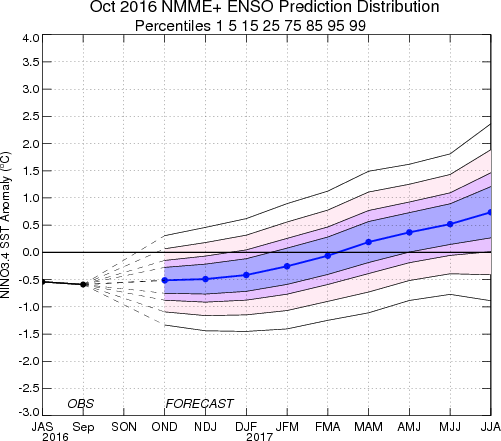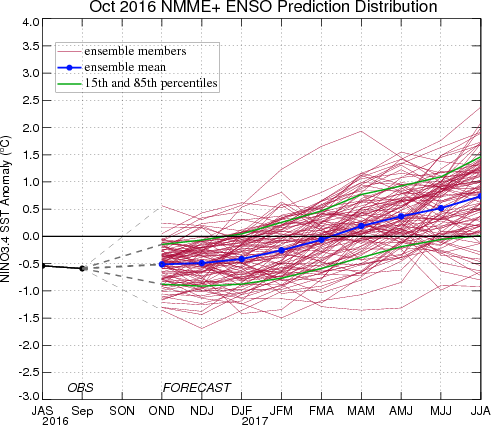IRI ENSO Forecast
IRI Technical ENSO Update and Model-Based Probabilistic ENSO Forecast
Published: October 20, 2016
Note: The SST anomalies cited below refer to the OISSTv2 SST data set, and not ERSSTv4. OISSTv2 is often used for real-time analysis and model initialization, while ERSSTv4 is used for retrospective official ENSO diagnosis because it is more homogeneous over time, allowing for more accurate comparisons among ENSO events that are years apart. During ENSO events, OISSTv2 usually shows stronger anomalies than ERSSTv4, and during very strong events the two datasets may differ by as much as 0.5 C.
Recent and Current Conditions
ENSO-neutral conditions were observed in most ENSO-related variables from May through July 2016. Then in August the average NINO3.4 SST anomaly was -0.54 C, and in September it was -0.59 C, both indicative of a weak La Niña SST condition. For Jul-Sep it was -0.54 C. The IRI’s definition of El Niño, like NOAA/Climate Prediction Center’s, requires that the SST anomaly in the Nino3.4 region (5S-5N; 170W-120W) exceed 0.5 C. Similarly, for La Niña, the anomaly must be -0.5 C or less. The climatological probabilities for La Niña, neutral, and El Niño conditions vary seasonally, and are shown in a table at the bottom of this page for each 3-month season. The most recent weekly anomaly in the Nino3.4 region was -0.x, at a weak La Niña level. Accompanying this ocean condition are atmospheric variables that also indicate weak La Niña. However, the lower-level trade winds have been enhanced only for about one month, and have only been enhanced modestly, and mainly only near and west of the date line. Convection anomalies across the equatorial Pacific have been somewhat suggestive of La Niña, and the same is true for the Southern Oscillation Index (SOI). Overall, despite the SST and the roughly consistent atmospheric variables, the diagnosis of weak La Niña is has not yet been made, mainly because the trade wind anomalies have not sufficiently stood the test of time (more than 1 month is desired, and a more eastward-extended swath is desired).
Expected Conditions
What is the outlook for the ENSO status going forward? The most recent official diagnosis and outlook was issued one week ago in the NOAA/Climate Prediction Center ENSO Diagnostic Discussion, produced jointly by CPC and IRI; it carries a La Niña watch and called for a roughly 70% likelihood of La Niña conditions during fall (already underway) 55% for La Niña in winter 2016-17. The latest set of model ENSO predictions, from mid-October, now available in the IRI/CPC ENSO prediction plume, is discussed below. Currently, the Nino3.4 SST anomalies are at the level of weak La Niña. Subsurface temperature anomalies across the eastern equatorial Pacific continue to be somewhat below average. Slightly enhanced easterly trade winds have been observed in the west-central tropical Pacific, suggestive of La Niña, but not compelling so far. The pattern of sea level pressure (e.g., the SOI), the upper level winds, and the pattern of tropical convection have been more suggestive of La Niña, so that overall, the atmosphere and ocean do appear La Niña-like in mid-October. But the hitch is that these conditions are instantaneous (or, just a mean over one week), and the question of endurance causes some to doubt that the ocean-atmosphere coupling is really in motion. The negative subsurface heat content anomaly may support the extension of the enhanced trades farther east in the tropical Pacific, which would present a more compelling picture of a La Niña. When and if these develop, the SST could remain in the weak La Niña category, or even strengthen somewhat, during the rest of 2016 and into the early part of 2017. The collection of the latest model predictions suggest that this scenario is about 55-60% likely.
As of mid-October, 62% of the dynamical or statistical models predicts La Niña conditions for the initial Oct-Dec 2016 season, while 38% predict neutral ENSO. At lead times of 3 or more months into the future, statistical and dynamical models that incorporate information about the ocean’s observed subsurface thermal structure generally exhibit higher predictive skill than those that do not. For the Jan-Mar 2017 season, among models that do use subsurface temperature information, 38% predicts La Niña conditions and 62% predicts ENSO-neutral conditions. For all model types, the probabilities for La Niña are over 60% for Oct-Dec 2016 and Nov-Jan 2017, 46% for Dec-Feb 2016-17, then drop to near 30% for Jan-Mar and drop further to about 10-20% from Feb-Apr to Jun-Aug 2017. The probability for neutral conditions is at least 50% beginning in Dec-Feb 2016-17, and rises to at least 80% from Feb-Apr to Apr-Jun 2017, then drops somewhat for later seasons. Probabilities for El Niño are near zero until Mar-May 2017, when they rise to 5%, and then up to around 20% for May-Jul and Jun-Aug.
Note – Only models that produce a new ENSO prediction every month are included in the above statement.
Caution is advised in interpreting the distribution of model predictions as the actual probabilities. At longer leads, the skill of the models degrades, and skill uncertainty must be convolved with the uncertainties from initial conditions and differing model physics, leading to more climatological probabilities in the long-lead ENSO Outlook than might be suggested by the suite of models. Furthermore, the expected skill of one model versus another has not been established using uniform validation procedures, which may cause a difference in the true probability distribution from that taken verbatim from the raw model predictions.
An alternative way to assess the probabilities of the three possible ENSO conditions is more quantitatively precise and less vulnerable to sampling errors than the categorical tallying method used above. This alternative method uses the mean of the predictions of all models on the plume, equally weighted, and constructs a standard error function centered on that mean. The standard error is Gaussian in shape, and has its width determined by an estimate of overall expected model skill for the season of the year and the lead time. Higher skill results in a relatively narrower error distribution, while low skill results in an error distribution with width approaching that of the historical observed distribution. This method shows probabilities for La Niña at 57% for Oct-Dec 2016, decreasing to 53% for Nov-Jan 2016-17, 47% for Dec-Feb, then droping more quickly and reaching 22% for Feb-Apr 2017, and to less than 20% from Mar-May through Jun-Aug. Probabilities for ENSO-neutral are below 50% through Nov-Jan 2016-17, 51% for Dec-Feb, and higher than 50% through Jun-Aug 2017. Probabilities for ENSO-neutral reach about 80% for Mar-May. A plot of the probabilities generated from this most recent IRI/CPC ENSO prediction plume using the multi-model mean and the Gaussian standard error method summarizes the model consensus out to about 10 months into the future. The same cautions mentioned above for the distributional count of model predictions apply to this Gaussian standard error method of inferring probabilities, due to differing model biases and skills. In particular, this approach considers only the mean of the predictions, and not the total range across the models, nor the ensemble range within individual models.
In summary, the probabilities derived from the models on the IRI/CPC plume describe, on average, a likelihood for La Niña conditions near 50-60% for Oct-Dec 2016 and Nov-Jan 2016-17, dropping below 50% for subsequent seasons as the probability for ENSO-neutral rises above 50%. A caution regarding this latest set of model-based ENSO plume predictions, is that factors such as known specific model biases and recent changes that the models may have missed will be taken into account in the next official outlook to be generated and issued in early October by CPC and IRI, which will include some human judgement in combination with the model guidance.
Climatological Probabilities
| Season |
La Niña |
Neutral |
El Niño |
| DJF |
36% |
30% |
34% |
| JFM |
34% |
38% |
28% |
| FMA |
28% |
49% |
23% |
| MAM |
23% |
56% |
21% |
| AMJ |
21% |
58% |
21% |
| MJJ |
21% |
56% |
23% |
| JJA |
23% |
54% |
23% |
| JAS |
25% |
51% |
24% |
| ASO |
26% |
47% |
27% |
| SON |
29% |
39% |
32% |
| OND |
32% |
33% |
35% |
| NDJ |
35% |
29% |
36% |

IRI/CPC Mid-Month Model-Based ENSO Forecast Probabilities
| Season |
La Niña |
Neutral |
El Niño |
| OND 2016 |
57% |
43% |
0% |
| NDJ 2016 |
53% |
46% |
1% |
| DJF 2017 |
47% |
51% |
2% |
| JFM 2017 |
35% |
63% |
2% |
| FMA 2017 |
22% |
74% |
4% |
| MAM 2017 |
12% |
81% |
7% |
| AMJ 2017 |
10% |
74% |
16% |
| MJJ 2017 |
15% |
61% |
24% |
| JJA 2017 |
18% |
53% |
29% |





